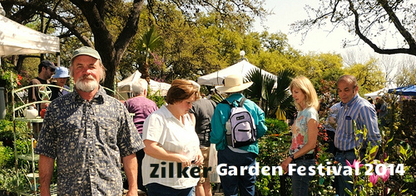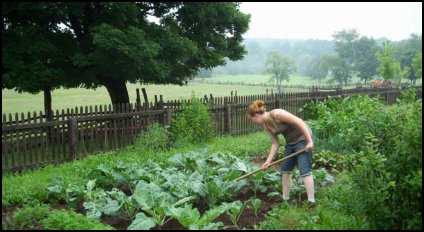
tel: 512 280-1192 Thursday, March 27 2014
Nursery Notes: our greenhouses are o'erflowing with veggies right
now, and our fruit trees are blossoming beautifully. Figs arrived
this week, along with delicate hybrid tea roses - in bush and climb-
ing form. The purples, oranges and golds of the bougainvilleas are
hard to resist at the moment - available in tubs or baskets. Give
Milkweed to the Monarchs - the butterflies are in need. Lots at the
nursery, along with Gregg's mist flower, a top butterfly nectar plant
for this area.

This weekend's highlight is without doubt going to be the Zilker
Garden Festival, a sort of ACL Fest for gardeners. Hundreds of
vendors, music, food, roses and a chance for the family to hang
out in this beautiful park. Our nursery will have its usual spot by
the front gates. Please drop by and say hi to Chris. Regular adult
tickets $7. Advance tickets: $5.50 Zilkerfest.
____________________________________________________
New Trellis ideas for Tomatoes: A fine article in Fine Gardening
by Joe Queirolo. You can try the Florida weave, the tripod, the
ladder, and even the spiral - making harvesting easier, and increas-
ing production. Fine Gardening
____________________________________________________
Finalmente Primavera (Finally Spring) A tasty and timely
pasta recipe by Chef Josh Toney from Edible Feast. Asparagus,
grape tomatoes, garlic, parmesan cheese... the usual suspects,
along with speck (a type of prosciutto) all come together to create
a delicious springtime supper.
_____________________________________________________
Central Texas Gardener: Beat the deer, drought, and cold with
succulents on Eric Pedley’s list from East Austin Succulents. On
tour, Ally and Richard Stresing tackled flooding to grow organic
food, native plants, and raise chickens in a raccoon-proof coop.
Sat. noon, 4 p.m. or Sun., 9 a.m. www.klru

An Intro to Vegetable Gardening
by Amanda Moon
Vegetable gardening has seen such a resurgence in popularity over
the last few years. With so many new gardeners out there, and with
spring finally in the air, it seems this is the perfect time for a re-
fresher course on the basics of vegetable gardening.
To begin with, site selection is one of the most important decisions
that you’ll make. Most vegetables need at least 6-8 hours of direct
sun each day. Whether grown in beds or pots, the absence of sun
will result in leggy, unproductive plants.
Keep in mind how the sun shifts throughout the year, and the leaf-
ing in of the deciduous tree canopy in the late spring and summer.
Also, the flatter the garden the easier it is to uniformly water every-
thing. Create terraces if your only sunny choice is on a slope.
The next decision is what to grow your veggies in: a raised bed, or
plant them straight into tilled ground. Take into consideration the
type of soil in your yard, drainage, how much you want to grow,
and how much time you have to spend in the garden.
Gardening on flat soil, tilling up the original ground, is the quickest
way to get started if you have some depth to your soil. Raised beds
are a necessity for many in the Austin area because of our shallow
soil. You can easily build one out of anything that will hold dirt,
from rock and lumber to galvanized tin or cinder blocks. (Avoid
treated railroad ties or telephone poles.)
Another thought is ease of harvesting. If bending over is taxing,
then raised beds or containers may be the best option.
Soil is the next important consideration. If you’re tilling up the
ground, you may be able to just work in lots of compost and get
planting.
For those of us without that luxury, the choices can be daunting. For
smaller raised beds or containers a combination of a good quality
potting soil, garden mix and compost from bags is probably the
easiest way to go. (I am a Metro Mix fan.) If you’re planning a
larger scale raised bed system, then the most economical approach
is to buy soil in bulk.
Look for a high quality garden blend - something that is not mostly
topsoil and sand. The way to calculate how much soil you need is
to multiply L (feet) x W (feet) x D (inches) / 324 to get the cubic
yards required to fill your new beds.
Vegetables need more water than flowerbeds and during the summer
may need to be watered every day. A mulch of pine straw, weed-
free hay and or newspaper will help to conserve moisture and keep
down weeds.
Fertilizing is also critical for good production as many vegetables
require lots of “juice” to reach their potential. I always start with
a round of manure compost and granulated organic fertilizer in
the planting holes and then foliar feed with an organic spray (like
seaweed or Hasta Grow) every few weeks throughout the season.
Compost alone is not always enough, especially in raised beds or
containers where the soil can be depleted of nutrients faster than
in the ground.
A few final tips to get you started:
1. Deer, rabbits and birds (and dogs) love gardens. Physical barriers
are the best prevention.
2. Stay on top of the weeds; they can get out of control in a hurry.
3. If you have the space, crop rotation is important for keeping plant
specific soil diseases and pests from gaining a foothold in the garden.
Lastly, don’t forget to enjoy the fruits of your labor. Gardening is hard
work, but the rewards can be amazing. Nothing tastes better than a
home grown tomato, or fresh corn straight off the plant! Even okra is
great raw when eating straight out of the garden.
Have fun, try new varieties and even an exotic recipe or two. The sky’s
the limit when you get to choose what you grow.
Happy Gardening Everyone.  Visit the website: www.itsaboutthyme.com
Visit the website: www.itsaboutthyme.com Visit the nursery:11726 Manchaca Road, Austin, 78748 Like us
on facebook